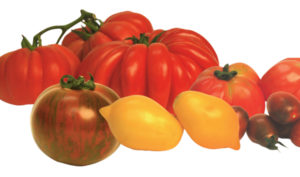Ugly Is In
The beauty of heirloom seeds—and the fruits and veggies they produce—is more than skin deep.
By Lynn Coulter | Photos By Jamie Cole
Noticed any lumpy, bumpy tomatoes in your produce department lately? Probably not. Sometimes called “ugly tomatoes,” they’re typically older, heirloom varieties that aren’t often sold in grocery stores. And that’s too bad, because if you’ve ever eaten one, you know, heirlooms are loaded with their own rich, meaty taste.
For a long time, heirloom tomatoes, along with many other older varieties of fruits and vegetables, almost vanished from our grocery stores and gardens. They gave way to hybrid varieties that were developed for better resistance to many diseases and for the ability to withstand the long haul from faraway locales where fruits and vegetables can be grown during what is off-season elsewhere. Grocers wanted peaches and pears that wouldn’t spoil quickly, and truckers needed easy-to-stack, oblong watermelons, instead of the kind that rolled around like bowling balls. And, thanks to hybrids, those of us who don’t like the “burp” in old-fashioned cucumbers, can now grow or buy mild cukes instead.
To be sure, many hybrids offer improvements. Yet, in recent years, many Americans have begun to miss the uniqueness of heirlooms. Each variety offers a singular flavor and many are naturally adapted to specific regions and climates, so they often require less water and chemical pesticides than newer varieties. Heirlooms are also valuable for their genetic diversity. Remember Ireland’s potato famine? It happened largely because farmers depended too much on one variety that succumbed to blight. Growing from a rich gene pool can help prevent whole-crop failures.
Finding heirloom seeds, however, may take a little effort, because many have virtually disappeared from the commercial seed and plant trade. But fear not: Specialty seed companies and exchanges offer opportunities to acquire seeds, as well as terrific tips on how to grow them. We offer a list of a few of these sources and a story on our website about the very popular Old-Timey Seed Swap held each spring. (See below for more info.)
Heirlooms are part of our own past. They’re a legacy from all the gardeners who have gone before us, a rich inheritance of taste, flavor and beauty handed down from one generation to the next. That’s reason enough to keep them going.
Learn More
Gardening with Heirloom Seeds: Tried-and-True Flowers, Fruits, & Vegetables for a New Generation (UNC Press, 2006), by the author of this story, Lynn Coulter.
Seed to Seed: Seed Saving and Growing Techniques for Vegetable Gardeners (Seed Savers Exchange, 2002), by Suzanne Ashworth and Kent Whealy.
Where To Buy Heirloom Seeds
Seed Savers Exchange, a non-profit, member-supported organization. http://www.seedsavers.org/
Southern Exposure Seed Exchange. Specializes in varieties adapted to the Mid-Atlantic region. http://www.southernexposure.com/
D. Landreth Seed Company, based in Pennsylvania. http://www.landrethseeds.com/





